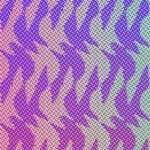
Linda has been weaving for fifty years, learning to weave as a child from her mother (also a member of Complex Weavers). She has always been fascinated with pattern and block designs, finding ways to maximize both on four shafts before moving on to multi-shaft looms. For the last 20-plus years, she has been exploring the interaction of color and structure to develop increasingly complex designs, with the assistance of Fiberworks and Photoshop software. She shares her findings through teaching, participation in two CW study groups (Double Weave and Fabric Design), and contributing articles to the CW Journal.

Double Two-Tie in Parallel
I developed a method for drafting familiar double two-tie (D2T) structures using a parallel tie-up and treadling, rather than the straight draw method in common use. This method is useful for drafting block designs in the tie-up. And it also turns out to be a powerful tool for discovering novel weave structures, and novel combinations of structures, for use on D2T threadings.
Using Fiberworks weaving software and the parallel method, I will demonstrate how to draft block designs in the tie-up on a D2T threading. Then I will introduce the method I used to explore, document, and combine novel weave structures for use in block designs. Participants will have the opportunity to examine woven samples of hundreds of these novel structures and combinations. I will finish with a preview of how these ideas can be applied to parallel threadings, especially extended parallel threadings.
Materials fee: None
Supplies: None

Tessellations are Cool!
Tessellations use the repetition of a uniform shape/tile to fill a surface without overlaps or gaps, most famously seen in the artwork of M. C. Escher.
Tessellating patterns in weaving tend to be shaft hungry, as two pattern blocks are required for one block in the tile/shape. However, this limitation does not apply to certain kinds of tessellations woven on extended parallel block threadings which already use block patterns woven on opposites.
I will show how the tie-ups for extended parallel block threadings create tessellating patterns based on “translation”. Then additional symmetry operations will be added (rotation, glide, and reflection) to create more interesting shapes and designs. Software will be used to create tessellating designs which are then transferred to the tie-up to draft these designs in various structures (some familiar, some novel) on an extended parallel block threading.
Materials fee: None
Supplies: None
